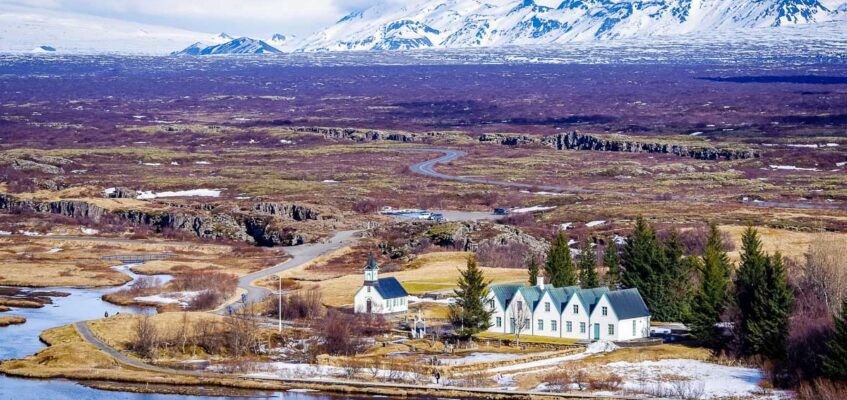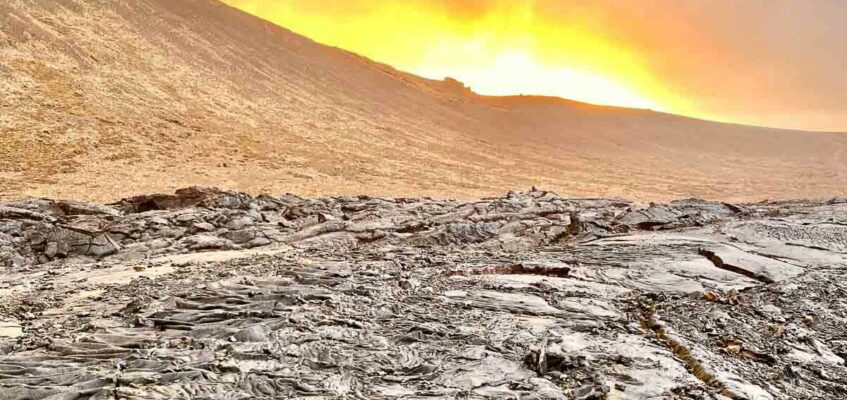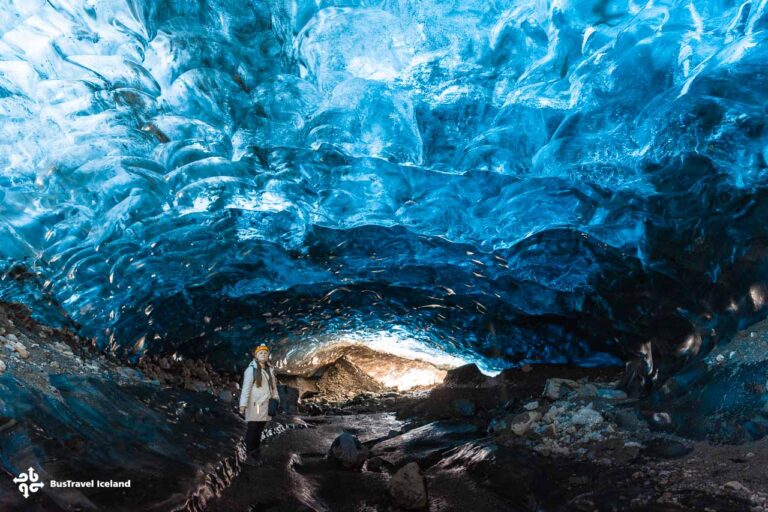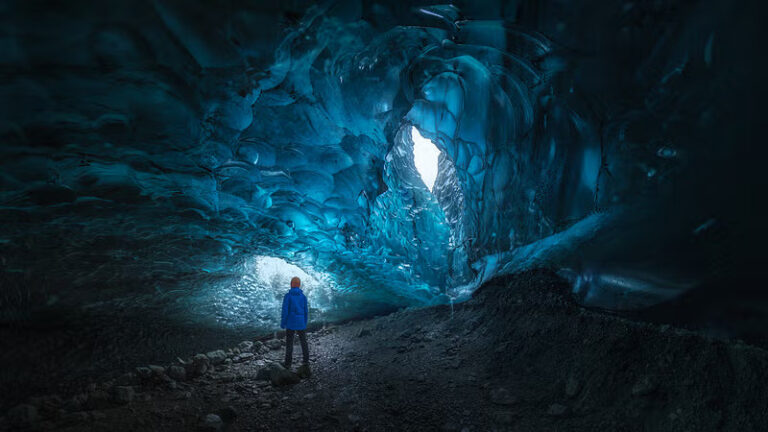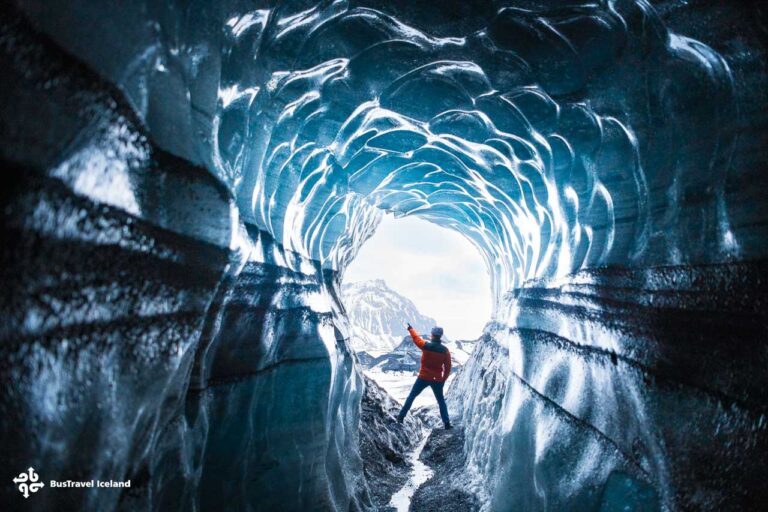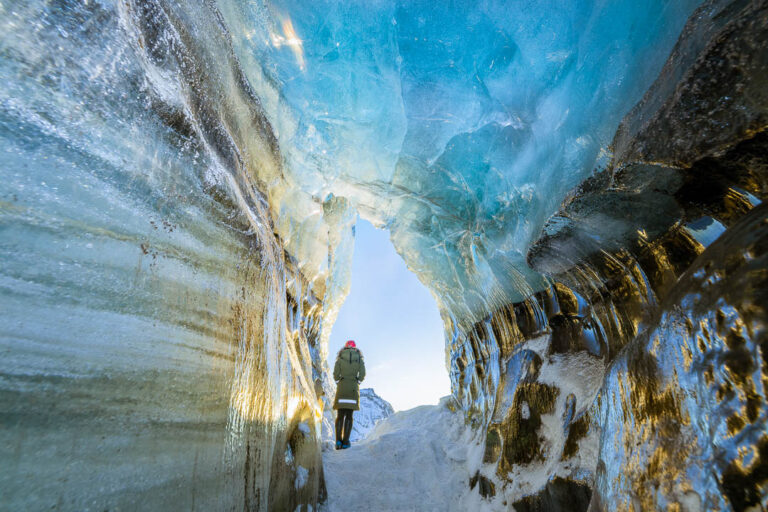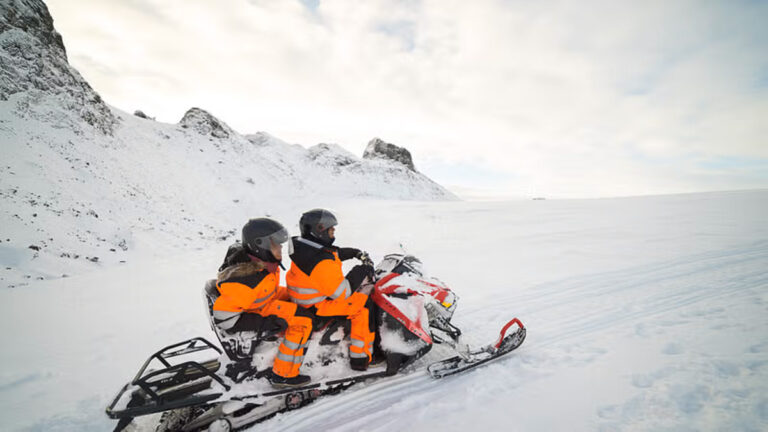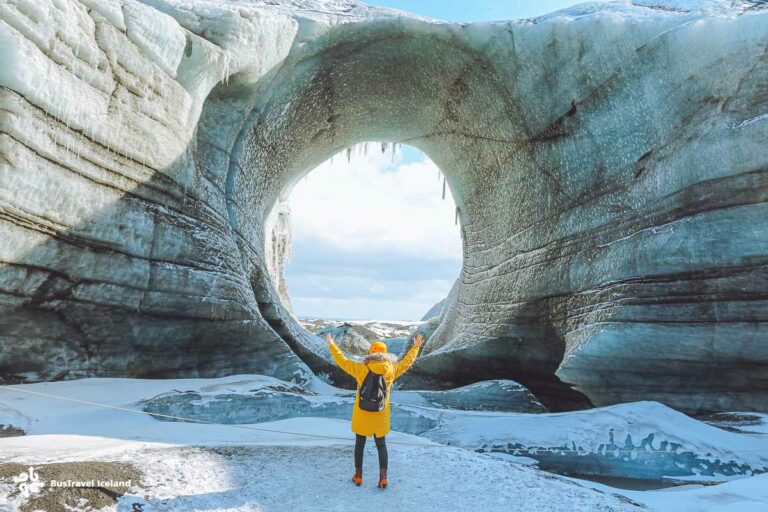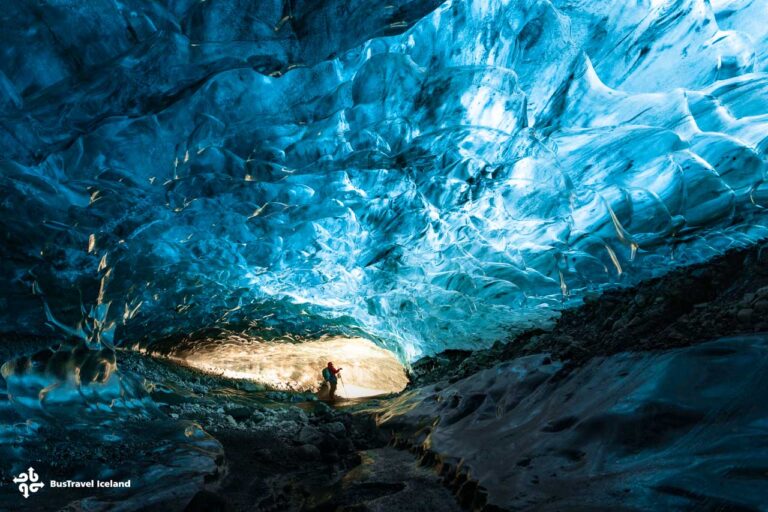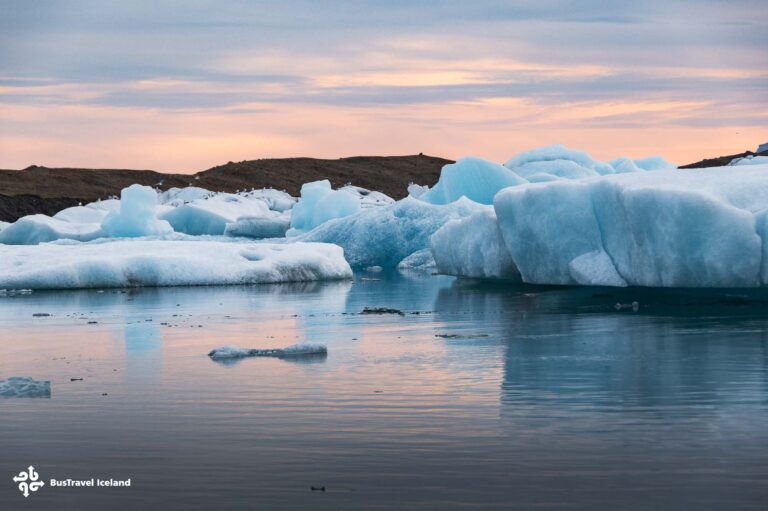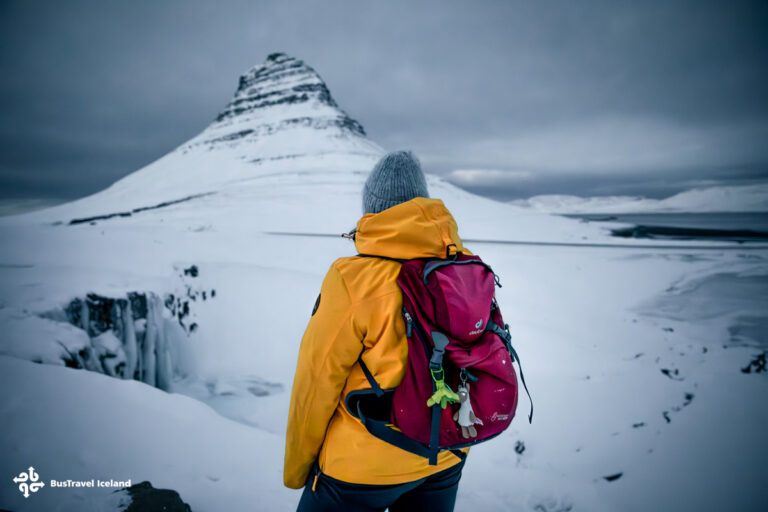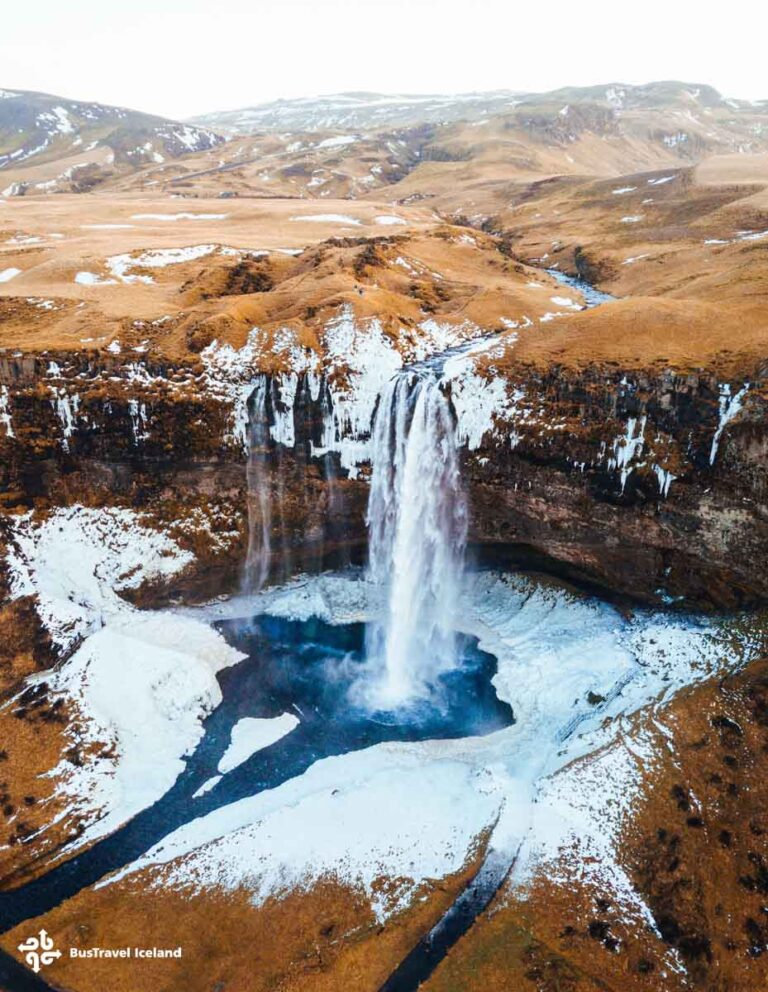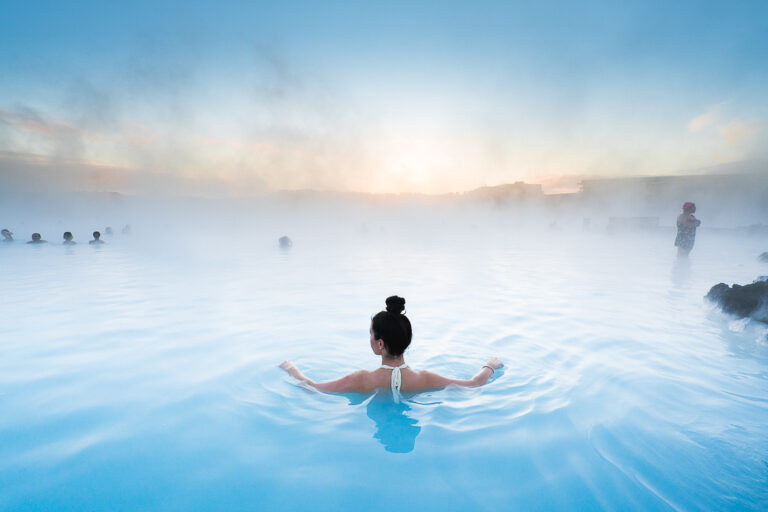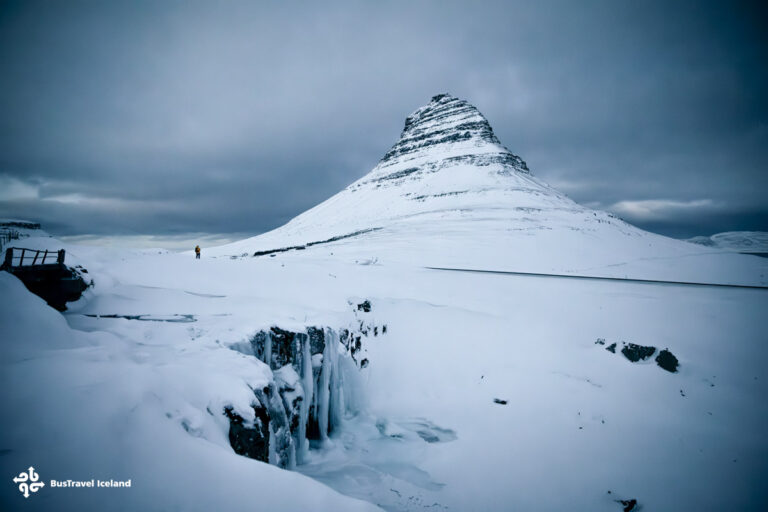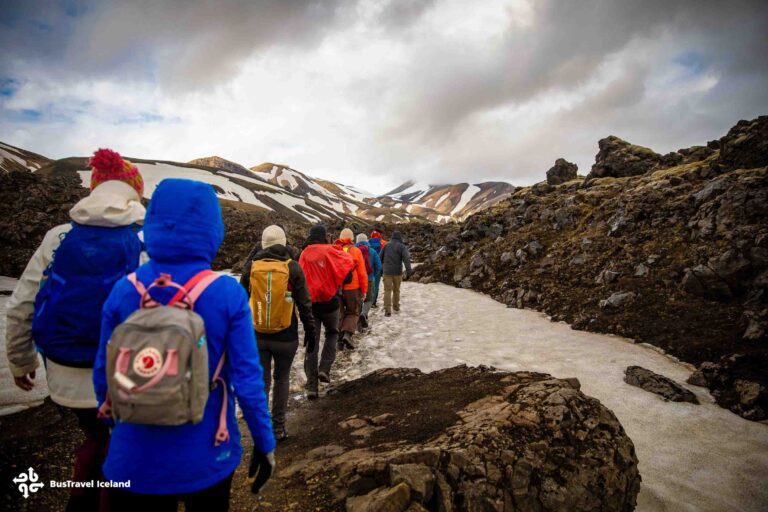Ice Caves in Iceland: The Complete Guide
- Good to Know, South Iceland
- 26 May 2025
Step inside Iceland’s otherworldly ice caves — where ancient glaciers glow in electric blue and each winter sculpts a new frozen cathedral. From how these natural wonders form to when and where to find them, this guide explores everything you need to know about one of the planet’s most breathtaking (and fleeting) experiences.
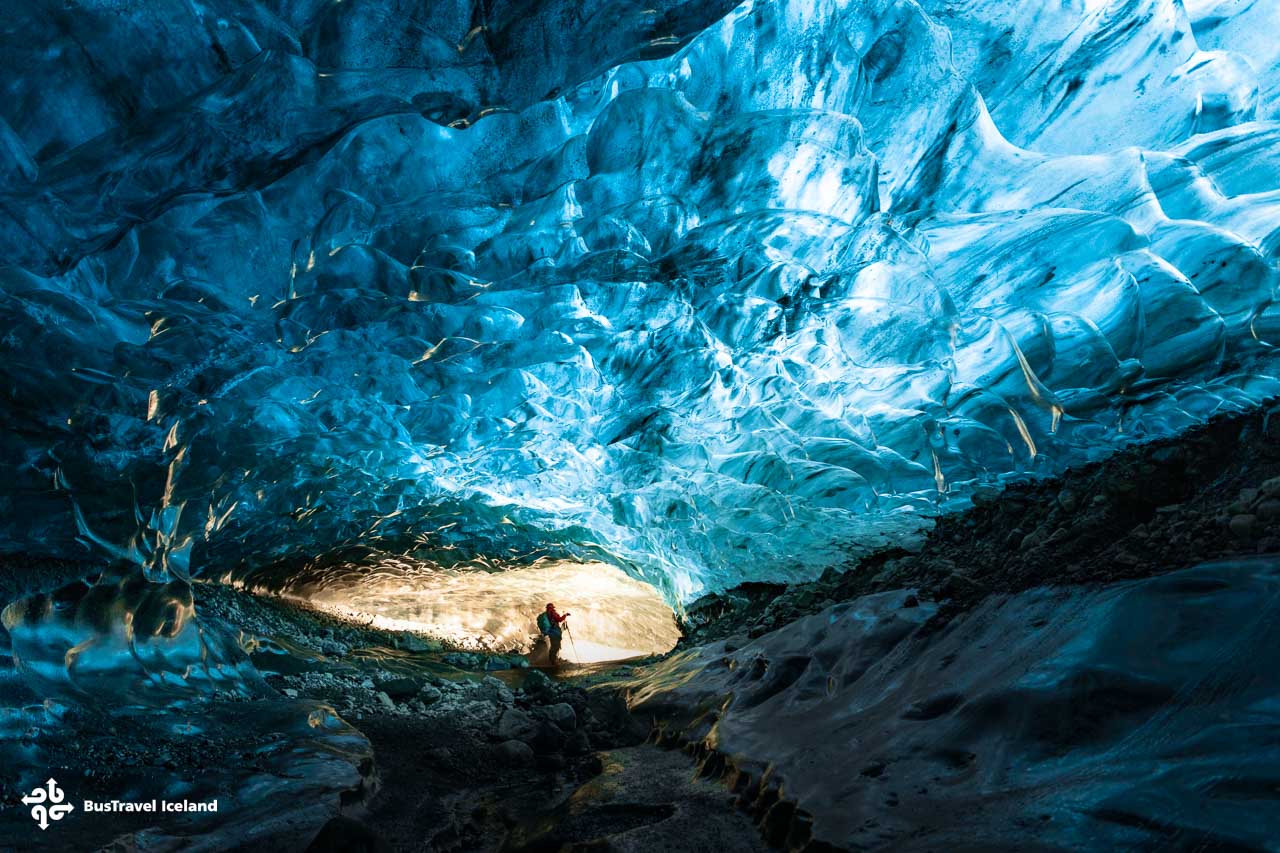
Entering an ice cave beneath an Icelandic glacier is a surreal experience — one that engages all the senses. The air grows colder and still, the light dimmer, and the walls around you begin to glow in brilliant shades of blue, sculpted naturally by centuries of pressure and motion.
The terrain beneath you can vary — icy and smooth in some places, rough with loose stones in others, and occasionally crossed by shallow streams from glacial melt. Each step reveals new textures and colors, as the ice refracts light like crystal.
These ice formations are seasonal, often forming in late autumn and becoming safe enough to explore in winter. By spring, many are gone — melted, shifted, or collapsed — making each visit a rare encounter with one of nature’s most transient wonders.
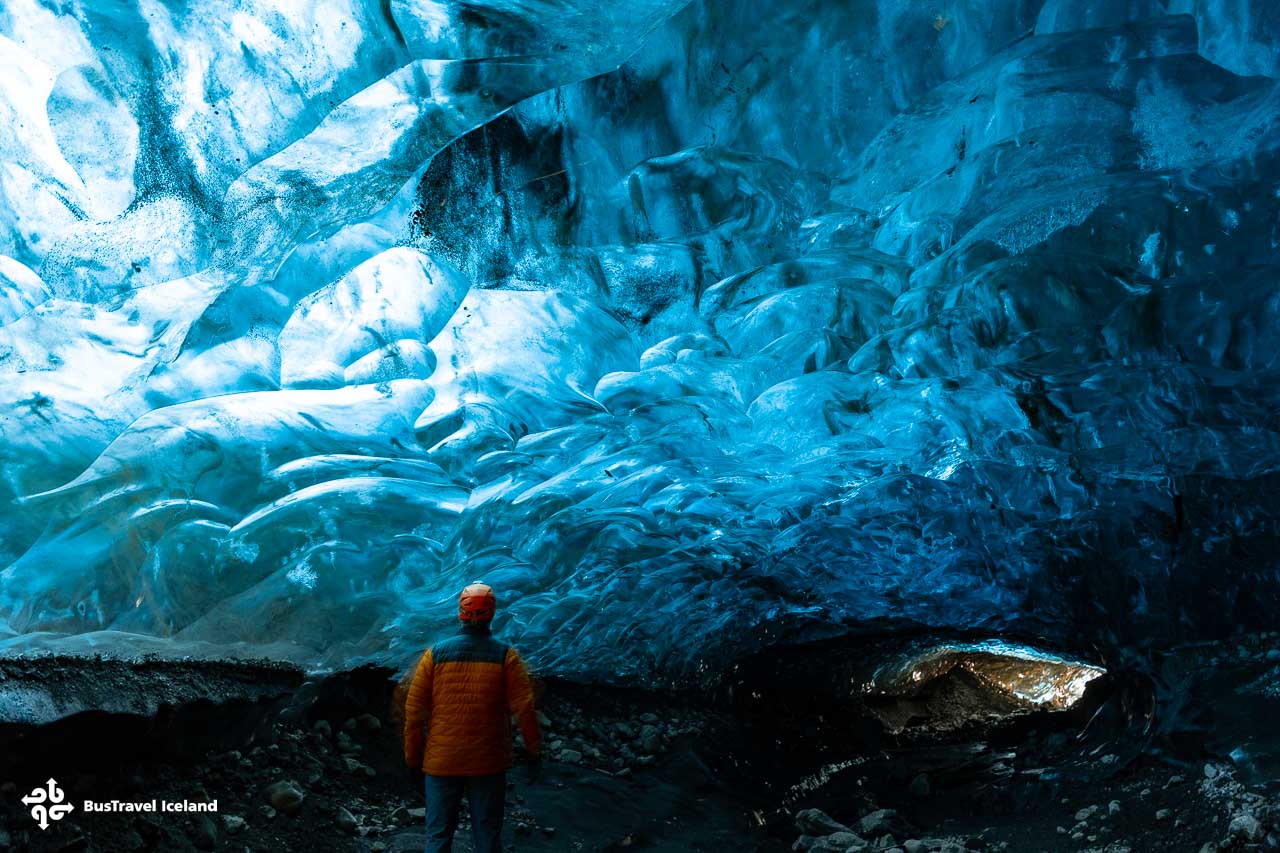
What Are Ice Caves?
Ice caves in Iceland are naturally formed cavities within glaciers — temporary tunnels and chambers sculpted by melting water, shifting ice, and time.
Despite the name, these are not permanent caves made of rock with ice inside them. In Iceland, the term usually refers to glacier caves, meaning ice caves form entirely within the ice itself.
Each summer, warmer temperatures cause glacial ice to melt. The meltwater flows through cracks and crevasses, carving narrow channels and wide chambers inside the glacier.
When winter returns and temperatures drop, these passages solidify and stabilize, making them accessible — though only for a short window of time.
What makes Iceland’s ice caves especially unique is their ever-changing nature. Glaciers are constantly moving, and the caves within them shift, collapse, or disappear altogether from year to year. No two seasons are alike, and many caves exist for only a single winter.
In Iceland, when people say ice cave, they usually mean a glacier cave — a tunnel or chamber formed inside a glacier, made of ice. Technically, though, not all ice caves are glacier caves, and the distinction matters in a scientific or geological context.

Why Glacial Ice Looks So Strikingly Blue
Glacial ice has a beautiful, deep blue color that sets it apart from the white or cloudy ice we see in everyday life — and it all comes down to how it forms and how it interacts with light.
Unlike regular ice, which forms quickly and traps lots of air bubbles, glacial ice is created over hundreds or even thousands of years. As layers of snow fall and compact over time, the pressure increases and slowly squeezes out almost all of the air trapped between the flakes. This compression process turns snow into incredibly dense, crystal-clear ice.
Now, here’s where the magic of light comes in. Sunlight might look white to our eyes, but it’s actually made up of all the colors of the rainbow. As light enters the dense glacial ice, the ice begins to absorb some of that light.
The red, orange, and yellow wavelengths are absorbed first, while the blue light — which travels in shorter, higher-energy wavelengths — is scattered and reflected back out. That’s why glacial ice appears such a vivid, rich blue.
In contrast, the ice from your freezer hasn’t been under intense pressure and is full of tiny air pockets. Those bubbles scatter all the light in different directions, making the ice look white or cloudy instead of colorful.
So in short: glacial ice is blue because it’s old, dense, and pure — and it interacts with light in a way that leaves only the bluest hues behind.

Where to Find Ice Caves in Iceland
Iceland is home to several glaciers that host accessible ice caves during the winter months, each offering a unique glimpse into the frozen landscapes beneath the surface. While ice caves can technically form in many of the country’s glaciers, only a few locations are regularly explored and considered safe for guided tours.
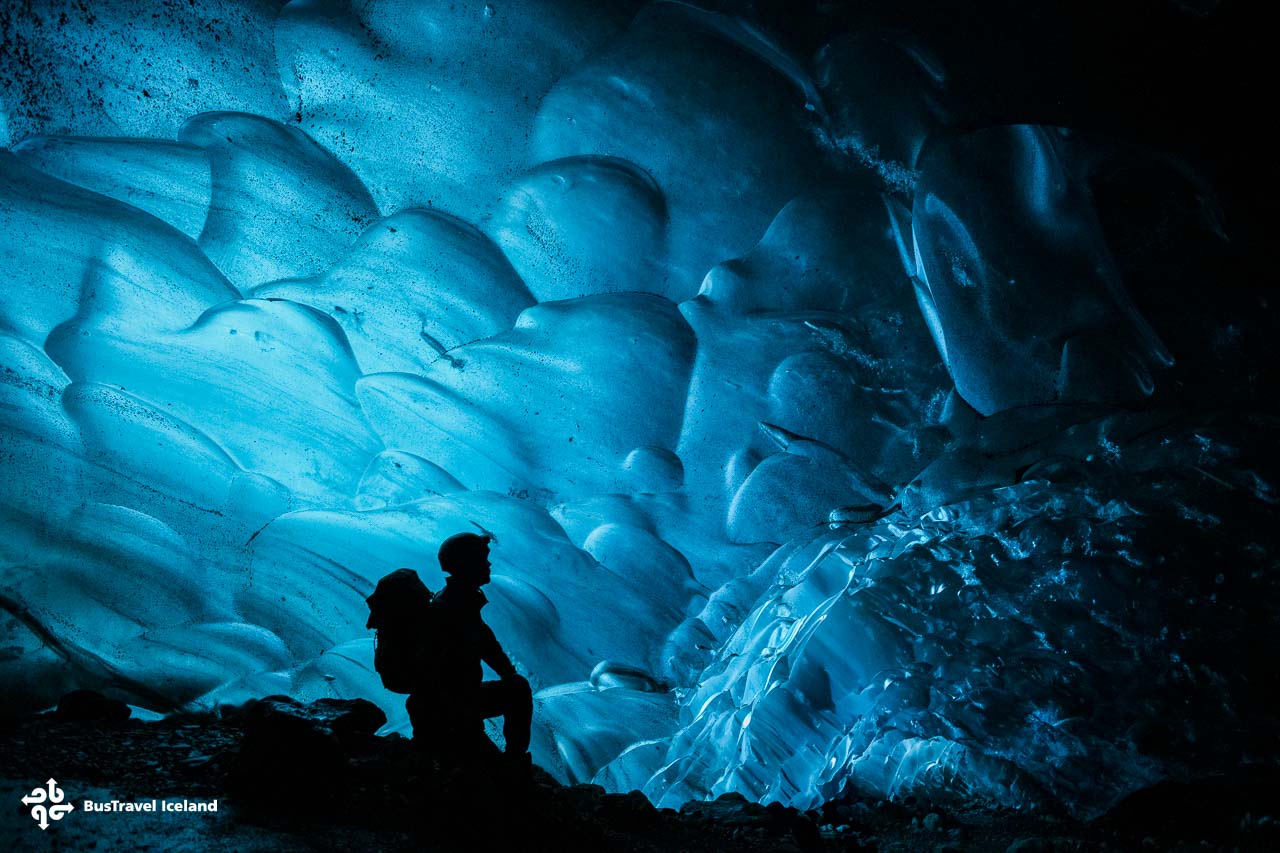
Vatnajökull Glacier
The largest glacier in Europe and the most popular for crystal ice cave tours.
Located in southeast Iceland, Vatnajökull is home to the most well-known and frequently visited “crystal ice caves”. Its massive size and active glacial flow make it ideal for the seasonal formation of large, photogenic caves — many of them glowing with vivid shades of blue.
Access points are often near Jökulsárlón Glacier Lagoon or Skaftafell Nature Reserve, making it a convenient stop along the popular Ring Road route. The larger area is called Vatnajökull National Park, a vast and dramatic expanse of glaciers, volcanoes, black sand plains, and ice-carved valleys — and home to some of the most awe-inspiring natural wonders in Iceland.
This glacier offers the most reliable conditions and the widest range of tour options, from easy hikes to more advanced excursions. If you’re looking to join a popular ice cave tour, the Crystal Ice Cave tour is your best bet.
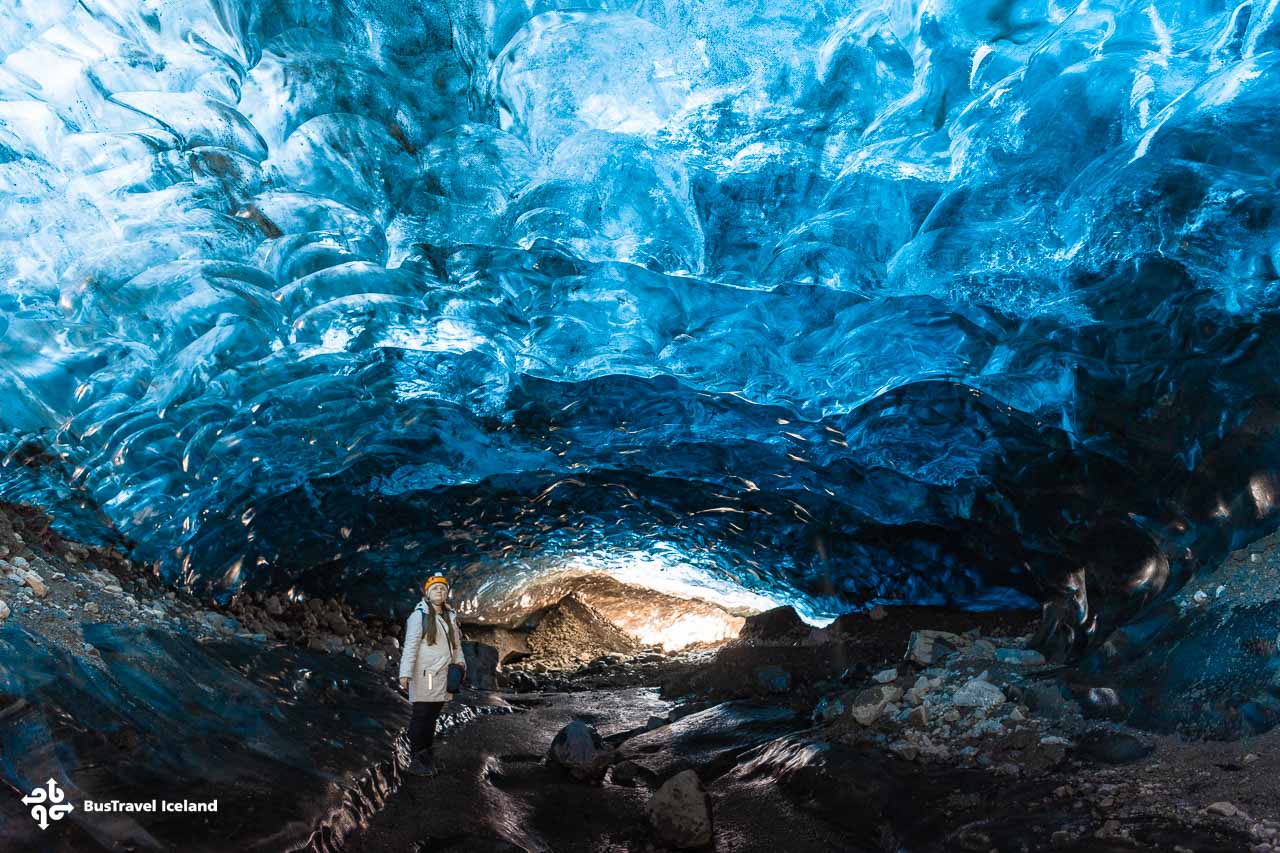
Langjökull Glacier
Known for man-made tunnels and easy access from Reykjavík.
Langjökull, Iceland’s second-largest glacier, is located in the country’s west-central highlands. It’s home to the Into the Glacier experience — a unique, man-made ice tunnel carved deep into the glacier itself, allowing visitors to explore the inner structure of the ice year-round.
In addition, natural ice caves sometimes form on its edges in winter, which are accessible via super-jeep tours. It’s an unforgettable opportunity to explore both the glacier and ice cave in one thrilling, once-in-a-lifetime journey.
Its proximity to Reykjavík makes it one of the more accessible options for shorter trips.

Mýrdalsjökull Glacier – Katla Ice Caves
A dramatic setting near an active volcano.
Situated in southern Iceland, Mýrdalsjökull covers the Katla volcano, one of the most powerful and closely monitored in the country.
The Katla ice caves are particularly striking due to their dark volcanic ash layers mixed within the ice, creating dramatic patterns of black, white, and blue. These caves are accessible even year-round, though tours are highly weather-dependent due to the area’s volatility.
If you’re hoping to experience the unique “fire and ice” contrast—where volcanic ash and ancient glacial ice form striking layered patterns—the Katla Ice Cave offers something truly special that’s unique to Iceland and fascinating for everyone. Just be sure to check the weather conditions before booking your tour.
You can easily do it as a Katla ice cave day tour from Reykjavik, especially if you combine it with a spectacular South Iceland sightseeing trip—featuring black sand beaches, famous waterfalls, and more.
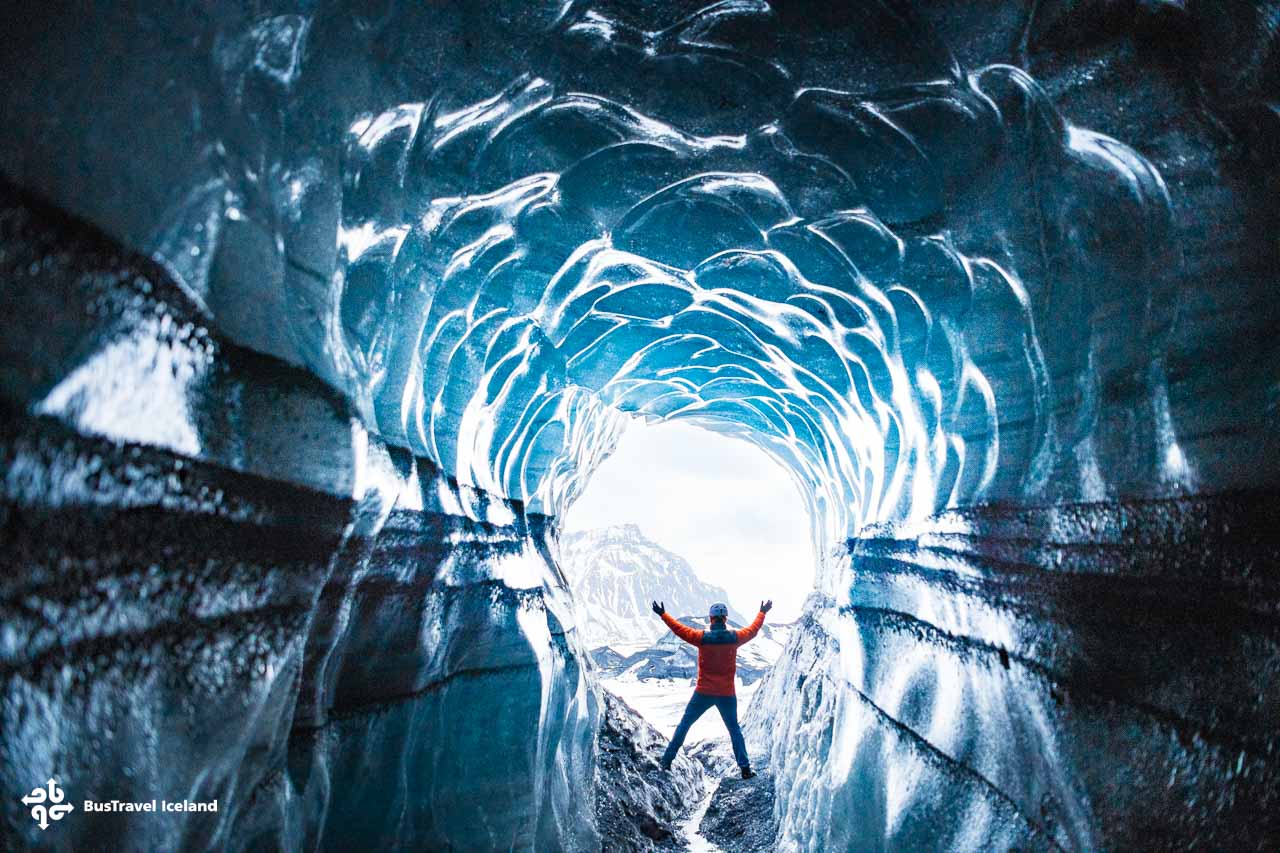
Each of these glaciers in Iceland offers a distinct experience, shaped by geography, accessibility, and the natural forces at play beneath the surface. No two caves are ever the same — and that’s part of what makes exploring them so compelling.
When to Visit: Timing Your Ice Cave Adventure
The best time to visit Iceland’s ice caves is during the winter months, typically from November to March, when temperatures are cold enough to stabilize the glacier interiors. During this season, the ice hardens, meltwater recedes, and conditions become safe enough for professional guides to lead tours into the caves.
Ice caves are not permanent structures — they shift, collapse, and reform with the natural cycle of freezing and melting. Each summer, meltwater carves new tunnels through the glaciers, and by winter, those paths freeze again, creating entirely new cave systems. This constant transformation means no two seasons are ever the same, and many caves disappear completely by spring.
Because of their ephemeral nature, visiting an ice cave isn’t just a sightseeing activity — it’s a chance to experience something truly temporary, shaped entirely by the moment. If you’re planning a winter trip to Iceland, setting aside time for an ice cave tour is one of the most unique and memorable experiences you can include.

How to Visit — Tours & Safety
Exploring Iceland’s ice caves is an unforgettable experience — but it’s one that should only be done with a certified guide. Glacier caves are inherently unstable and constantly changing. Without the right knowledge, equipment, and local insight, entering one alone or without proper guidance can be extremely dangerous.

Ice Cave Tours in Iceland
All ice cave visits in Iceland require joining a guided tour, typically led by experienced glacier guides who monitor conditions daily.
These professionals assess ice stability, choose safe entry points, and provide essential safety gear, ensuring that your adventure is not only awe-inspiring but also secure.
What to Expect on a Typical Tour:
Transport by Super Jeep or 4×4 vehicle to reach off-road glacier access points
Safety gear provided, including a helmet, crampons (ice grips for your boots), and often a headlamp
A short hike across glacial terrain, which may include walking on ice, snow, or rocky surfaces
Time inside the cave to explore, take photos, and learn from your guide about how the cave was formed
Tours vary in difficulty, so there are options for both casual travelers and those seeking a more active experience.
Some tours even combine ice cave visits with glacier hiking or snowmobiling for a full-day adventure.
Choosing the Right Tour Company:
Look for operators that are: Licensed and insured Employ certified glacier guides with safety training. Provide clear information about difficulty level, gear, and group size. Have excellent reviews and updated schedules, as ice conditions can change quickly.

What to Pack & Wear: Staying Warm, Safe, and Camera-Ready
Ice cave adventures in Iceland often involve cold, wet, and uneven conditions — so dressing smartly and packing the right gear can make all the difference in your comfort and experience.
Clothing: Think Layers & Waterproofing
- Base Layer: Start with thermal underwear (top and bottom) to keep warmth close to your body.
- Mid Layer: A fleece or insulated jacket for added warmth.
- Outer Layer: A waterproof and windproof shell — essential for glacier winds, snow, and possible rain.
- Gloves & Hat: Choose warm, water-resistant gloves and a snug beanie or thermal hat.
Footwear: Stay Steady
- Hiking boots are a must — ideally waterproof, insulated, and with good ankle support. Crampons will be provided by most tour companies, but they’ll only fit properly on sturdy footwear.
Camera Tips: Capture the Magic
Ice caves are stunning but can be challenging to photograph due to low light and blue-toned reflections. Here’s how to prepare:
- Bring a camera with manual settings (DSLR, mirrorless, or a good smartphone with a pro mode).
- Use a tripod or mini tripod to stabilize long exposure shots.
- Avoid flash, as it flattens the natural glow of the ice.
- Pack spare batteries — cold temperatures drain them quickly.
Optional but useful: a dry bag or waterproof case to protect your gear in wet or icy conditions.
Packing right ensures you’re not just warm and safe, but also able to fully enjoy and capture the once-in-a-lifetime atmosphere inside the caves.

Photography Tips: Capturing the Ice Cave’s Magic
Photographing an ice cave can be as breathtaking as the visit itself — but the low light, reflective surfaces, and icy blues require a bit of planning to get it right. Whether you’re using a smartphone or a DSLR, here are a few tips to help you capture the textures, glow, and mood of these natural wonders.
How to Capture the Glow & Texture
- Use natural light as much as possible. The soft, diffused light entering the cave mouth helps bring out the glacier’s deep blues and layered textures.
- Long exposures (on a tripod) allow your camera to absorb more light and enhance the luminous quality of the ice.
- Look for details like trapped air bubbles, ash layers, and light beams — they add depth and storytelling to your shots.
- Shoot wide and close: Take wide-angle shots to show scale, then zoom in on details like swirling ice patterns or water droplets.
Best Time of Day for Lighting
- Midday tends to be the best, as the sun is higher and more light enters the cave. Since you’re inside a glacier, lighting is less about golden hour and more about maximizing what little ambient light you can get.
- Cloudy days actually work well — the diffused light prevents harsh shadows and keeps the ice color even and rich.
Phone vs. Camera
- Smartphones with manual or pro mode can do surprisingly well in modern models, especially if stabilized.
- DSLR or mirrorless cameras give you more control over ISO, aperture, and exposure — crucial in low-light cave conditions.
Tripods (even small, packable ones) are a game changer for both phones and cameras. Long exposure shots without blur are nearly impossible without one.

Environmental Considerations: Treading Lightly on Ancient Ice
Beneath the breathtaking beauty of Iceland’s ice caves lies a sobering reality — these natural wonders are fragile, temporary, and increasingly threatened by a warming climate. As global temperatures rise, glaciers across Iceland are retreating, thinning, and in some cases disappearing altogether. This not only impacts the formation and longevity of ice caves, but also the long-term health of the ecosystems and communities that depend on the glaciers.
Scientists have already observed significant shrinkage in major ice caps like Vatnajökull and Langjökull, with melt rates accelerating over the past few decades. The caves that tourists explore each winter are shaped by these forces — forming faster in some cases, but also collapsing sooner or vanishing entirely. Visiting an ice cave today is, in many ways, witnessing something that may not exist for future generations.

Practicing Responsible Tourism
With their delicate nature and limited accessibility, ice caves call for thoughtful, low-impact exploration. Here’s how visitors can help protect what they’ve come to admire:
- Stay on marked paths and follow all guide instructions — venturing off-route can damage the glacier surface or disturb sensitive features.
- Leave no trace — take nothing but photos, and pack out everything you bring in.
- Choose eco-conscious tour operators who use low-emission vehicles, limit group sizes, and contribute to conservation efforts. Many reputable companies are now incorporating sustainability into their mission, from carbon offsetting to glacier research support.
Tourism plays an important role in Iceland’s economy, but it also carries the responsibility of stewardship. By making mindful choices, visitors can help ensure that these icy cathedrals — sculpted by time, water, and cold — remain part of the landscape for as long as nature allows.

A Moment Inside the Ice
This past April, I had the chance to visit not just one, but two ice caves within the vast Vatnajökull Glacier — and the experience left a lasting impression far beyond the photographs.
The sheer scale of the caves was awe-inspiring. Towering walls of ancient, compacted ice surrounded us, glowing in shades of blue so rich and deep they seemed almost unreal — like frozen light. One cave arched above us like a cathedral, while the other felt like a twisting tunnel carved by time and water. Each step inside felt like entering another world, silent and slow and alive in its own way.
Our ice cave tour guide was outstanding — calm, professional, and deeply knowledgeable. He not only kept us safe, but also brought the experience to life with stories about the glacier’s formation, its seasonal changes, and where to stand to capture the best photos. Thanks to his guidance, I was able to take shots that truly reflected the mood of the caves — some capturing intricate ice textures, others bathed in soft, blue luminescence.
But beyond the photos, what struck me most was the realization of how ephemeral it all is. These incredible formations, shaped over centuries, might not exist next season. They’re vanishing slowly, invisibly, year by year.
To walk among them — just for a moment — felt like stepping into something ancient and fleeting. It was humbling, grounding, and quietly powerful.

Where to Stay and How to Plan Your Ice Cave Visit
If you’re heading to southeast Iceland to explore the ice caves, careful planning will make the experience far smoother — especially during the winter months, when weather can be unpredictable and daylight is limited.
Where to Stay: Basecamps for Adventure
The most popular ice caves — especially those in Vatnajökull Glacier — are accessed from areas near Jökulsárlón Glacier Lagoon, along the southern coast. Two of the best places to stay nearby are:
Höfn: A small fishing town about an hour east of Jökulsárlón, known for its welcoming guesthouses, seafood restaurants, and dramatic views of the Vatnajökull ice cap. It’s a great base for tours starting in the eastern glacier areas.
Around Jökulsárlón & Skaftafell: This region is dotted with farm stays, countryside hotels, and cozy cabins within 15–30 minutes of the main glacier access points. Accommodations here offer the advantage of proximity — especially helpful for early morning tours.
Keep in mind that places can book out quickly in winter, so reserving lodging well in advance is highly recommended.
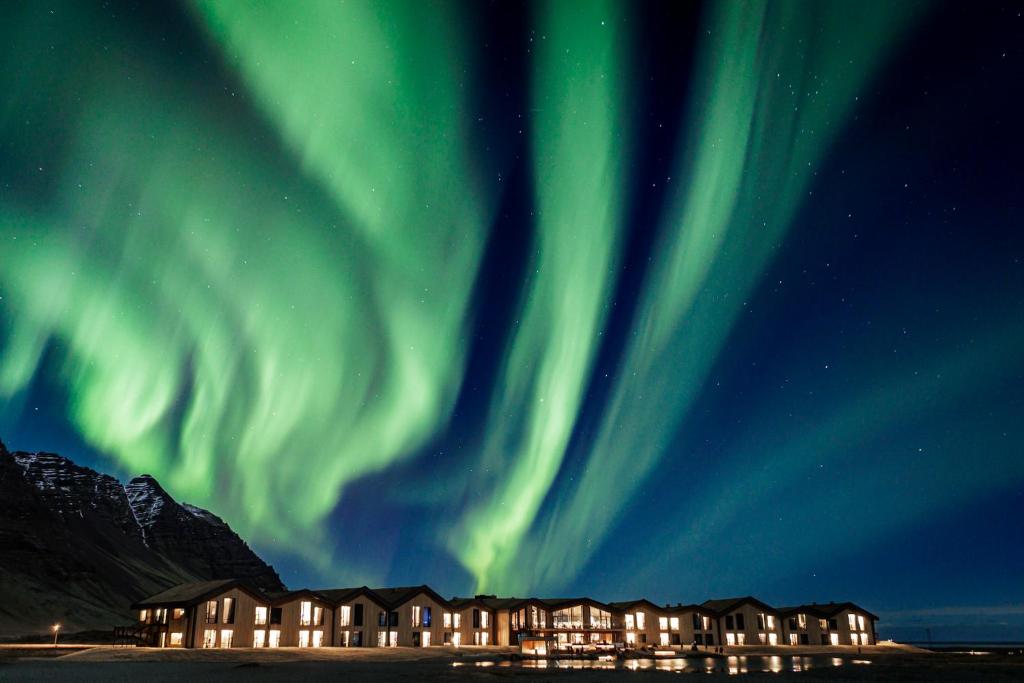
How Long to Plan For
If you’re traveling from Reykjavík, plan for at least a 2- to 3-day itinerary just for the ice cave portion. It’s about a 5–6 hour drive (one way) to the Jökulsárlón area, and winter road conditions can slow things down significantly. Many travelers choose to spend a night near Vik, then continue east toward the glacier the following day.
You’ll also want to build in extra time for:
Changing weather that can delay tours
Short daylight hours (only 4–6 hours of usable light in mid-winter)
Other attractions nearby, like Diamond Beach, Skaftafell, and Fjallsárlón
Winter Driving Conditions
Driving in Iceland in winter requires caution and preparation. Expect snow, ice, and strong winds — especially in exposed areas along the South Coast. Key tips:
- Rent a 4×4 vehicle with winter tires
- Check the Icelandic Road and Weather Administration daily for closures or warnings
- Avoid driving in the dark if you’re unfamiliar with icy roads or single-lane bridges
Always leave room for weather-related delays.

If you’d rather not drive yourself, there are excellent 2- to 3-day guided tours along Iceland’s South Coast that include or offer optional add-ons for ice cave visits. These tours typically depart from Reykjavík and cover major highlights such as Seljalandsfoss and Skógafoss waterfalls, Reynisfjara black sand beach, Vík, and Jökulsárlón Glacier Lagoon.
Many itineraries offer the ice cave tour as a featured experience in Vatnajökull, especially in winter months. These multi-day trips are a convenient, safe alternative for travelers who prefer to leave the winter roads to experienced local drivers, while still maximizing their time in Iceland’s most scenic region.
As the climate changes and glaciers retreat, these frozen sanctuaries are reminders of both nature’s creativity and its fragility. And so we go not just to marvel, but to remember — that what is extraordinary must also be protected.
If you ever have the chance to stand inside one of these glittering halls, take a breath, take it in. You’re not just witnessing a natural wonder — you’re stepping into a moment the earth made once and may never make again.

